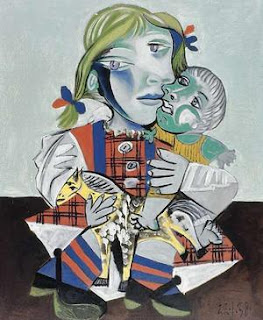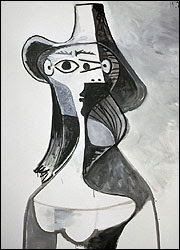

Two Picasso paintings stolen from his granddaughter Diana Widmaier-Picasso's house in Paris,police said Wednesday. The paintings are Maya and the Doll and Portrait of Jacqueline.
Though police only mentioned the two paintings, the director of the Picasso Museum, Anne Baldassari, said several paintings and drawings were stolen.
Picasso family lawyer, Céline Astolfe said in a telephone interview that Ms. Widmaier-Picasso and her mother, Maya, the daughter of Picasso’s longtime mistress Marie-Thérèse Walter, were asleep in the house when the theft occurred.
“They heard a noise, went downstairs and saw nothing,” Ms. Astolfe said. “They went to bed and the following morning they saw that two paintings were missing.”
The lawyer said the theft appeared to be the work of professionals because the home’s alarms were neutralized and there were no signs of a break-in. “They blocked the alarm, and they had either the code or keys,” she said.
"It was a very large theft," she said, without giving details.
The value of the two paintings is estimated to be about $66 million
The Pictures:
The burglars cut the edges of "Maya and the Doll," to take it out of its frame.
"Maya and the Doll" is a colorful portrait of a young blonde girl in pigtails, eyes askew in a Cubist perspective. Another version of the painting hangs in the Picasso Museum. It portrays Maya Widmaier, the daughter of Picasso and Marie-Therese Walter, his companion from 1924-1944.
The painting had sentimental value for Widmaier-Picasso: It shows her mother, Maya, as a young girl in pigtails, eyes askew in an off-kilter Cubist perspective. A similar version of the painting hangs in the Picasso Museum in Paris.
Maya was the artist's daughter with Marie-Therese Walter, whom he met when she was a fresh-faced, blonde teenage girl. Their affair did not last.
Four years after Picasso died in 1973, Walter committed suicide by hanging herself.
Maya married Pierre Widmaier had three children, Olivier, Richard and Diana Widmaier-Picasso, an art historian and author of a book called Art Can Only be Erotic.
The other missing painting was "Portrait of Jacqueline," and the burglars took the frame with it, police said. That painting showed Picasso's second wife Jacqueline.
Neither Diana Widmaier-Picasso nor her mother could be reached on Wednesday.
Other missing Picaso's
The Art Loss Register, which maintains the world's largest database on stolen, missing and looted art, currently lists 444 missing Picasso pieces, including paintings, lithographs, drawings and ceramics.
Among recent missing Picasso's reported to the register was the theft of an abstract watercolor stolen in Mexico, said staff member Antonia Kimbell.
The number of missing Picasso's is so high simply because Picasso was so prolific, Kimbell said. She said the Paris theft was "definitely quite significant."
Picasso's treasured paintings
After Picasso died of a heart attack in 1973, his heirs divided up the paintings that he treasured over the years - which might explain why Widmaier-Picasso ended up with a painting of a woman who was not her mother.
The stolen paintings were important because they were works Picasso chose to keep, said Pepe Karmel, an associate professor at New York University and the author of "Picasso and the Invention of Cubism."
"They were meaningful to him, so he didn't sell them," he said.
The artist’s descendants have had artworks stolen before. One famous theft involved pieces worth about $17 million, taken from the Cannes home of Marina Picasso, another of his granddaughters, in 1989. Those were later recovered.
-------------------------------------
Books mentioned in article:



